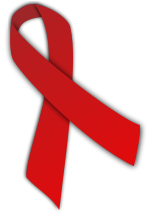| World AIDS Day | |
|---|---|
 The red ribbon is the global symbol for solidarity with HIV-positive people and those living with AIDS. | |
| Observed by | All UN Member States |
| Type | International |
| Date | 1 December |
| Frequency | Annual |
| First time | 1988 |
World AIDS Day, designated on 1 December every year since 1988,[1] is an international day dedicated to raising awareness of the AIDS pandemic caused by the spread of HIV infection and mourning those who have died of the disease. The acquired immunodeficiency syndrome (AIDS) is a life-threatening condition caused by the human immunodeficiency virus (HIV). The HIV virus attacks the immune system of the patient and reduces its resistance to other diseases.[2] Government and health officials, non-governmental organizations, and individuals around the world observe the day, often with education on AIDS prevention and control.
World AIDS Day is one of the eleven official global public health campaigns marked by the World Health Organization (WHO), along with World Health Day, World Blood Donor Day, World Immunization Week, World Tuberculosis Day, World No Tobacco Day, World Malaria Day, World Hepatitis Day, World Antimicrobial Awareness Week, World Patient Safety Day and World Chagas Disease Day.[3]
As of 2020[update], AIDS has killed between 27.2 million and 47.8 million people worldwide, and an estimated 37.7 million people are living with HIV,[4] making it one of the most important global public health issues in recorded history. Thanks to recent improved access to antiretroviral treatment in many regions of the world, the death rate from AIDS epidemic has decreased by 64% since its peak in 2004 (1.9 million in 2004, compared to 680 000 in 2020).[4]
- ^ "About World Aids Day". worldaidsday.org. National Aids Trust. Archived from the original on 20 November 2015. Retrieved 4 December 2014.
- ^ "World AIDS Day 2020: Date, History, Current Theme, Importance, Significance". NDTV.com. Archived from the original on 1 December 2020. Retrieved 1 December 2020.
- ^ World Health Organization, WHO campaigns. Archived 31 December 2012 at the Wayback Machine
- ^ a b Global HIV & AIDS statistics — Fact sheet UNAIDS. Accessed 4 December 2021.